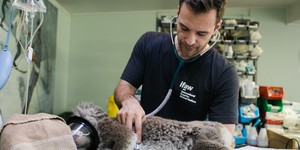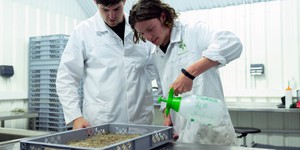Abstract
Has your dog ever barked, seemingly for no reason at all? Or has your cat ever stopped and carefully smelled a spot that looked perfectly clean to you? Pets, like people, have senses that they use to learn about and to react to their world, but their senses can be stronger or weaker than people's. In this mammalian biology science fair project, you'll study your pet's sense of taste by conducting taste tests and watching how your pet acts to determine his or her favorite type, flavor, or brand of treat. Does Fido like liver? Does Fluffy love fish? Does your poodle like biscuits? Or does she prefer bones? Get ready to find out!Summary
Kristin Strong, Science Buddies
The inspiration for this science fair project is the episode "The Deedle Beast" from CYBERCHASE on PBS KIDS GO!:
- Thirteen/WNET New York. (2008). CYBERCHASE: Episode 706: The Deedle Beast Educational Broadcasting Corporation, New York. Retrieved November 6, 2009.

Watch CYBERCHASE on PBS KIDS GO! Check local listings or visit pbskidsgo.org/cyberchase. CYBERCHASE is produced by THIRTEEN in association with WNET. All rights reserved. CYBERCHASE is a trademark of THIRTEEN. The PBS KIDS GO! logo is a registered mark of PBS and is used with permission.

Objective
To determine which type, brand, or flavor of pet treats a pet prefers.
Introduction
Do you think dogs hear fireworks the same way you do? Would a lick of ice cream taste the same to a cat as it does to you? Does a beautiful flower look the same to a bee as it does to you? All animals, including people, have senses to help them move through and react to their environments. The five senses for people are: touch, taste, sight, smell, and hearing. Many animals have these five senses, too, but their senses are usually stronger, weaker, or different than yours. Dogs, for example, have a much better sense of hearing than you do. They can hear high-pitched sounds that you cannot, and noises like fireworks that are loud to you, may be painfully loud and scary to them. Cats, too, have a very strong sense of hearing, but their sense of taste is weaker than yours. Cats are one of the few mammals who cannot detect sweetness with their tongues, so they have no preference for sweets in food. Both cats and dogs, though, have a much stronger sense of smell than you do, so the aroma (or smell) of their food is very important to making it taste good to them. Bees, on the other hand, cannot see the color red, but they can see types of light that you cannot see, like ultraviolet light (the kind of light that causes sunburns). Because bees see ultraviolet light, flowers look different to them than they do to you. While you see a solid yellow flower, a bee sees a flower with a "bulls eye"—a light outer area with a strongly colored center. Seeing in ultraviolet light helps a bee figure out right away where a flower's nectar is located.
Some scientists think that animals might even have senses that go beyond the standard five senses that you have. Animals have been known to act strangely right before earthquakes and tsunamis (tidal waves). For example, in the devastating 2004 tsunami in the island country of Sri Lanka, elephants were seen and heard screaming and running to higher ground before the tsunami hit the country. Dogs and zoo animals also refused to go outside their homes and shelters before the big wave struck, and flamingoes fled low-lying areas. These animals reacted to some sensory experience before people could sense that trouble was coming, and this helped to get them out of danger.
Scientists who study animal behavior are called ethologists. Animals can't talk to us, of course, so ethologists try to figure out what animals are sensing by watching their behavior (the way they act). In this mammalian biology science fair project, you'll get to study animal behavior, too, using your own pet. You'll focus on the sense of taste and set up taste tests, giving your pet several possible choices of treats. You'll then watch your pet's behavior closely to determine which flavor, brand, or type of treat is his or her favorite. Maybe you'll learn that Polly doesn't want a cracker after all!
Terms and Concepts
- Sense
- Mammal
- Behavior
- Ethologist
- Taste test
Questions
- What are the five types of senses that people have?
- Do animals have the same senses that people have?
- Are animals' senses stronger or weaker than people's?
- Why do scientists study animal behavior?
- Based on your research, how are taste tests conducted?
Bibliography
This science fair project is based on the following episode from CYBERCHASE on PBS KIDS GO!:
- PBS Kids Go! Cyberchase. (2008). Episode Descriptions: Episode 706: The Deedle Beast. Thirteen/WNET. Retrieved February 27, 2012.
- PBS Kids Go! Cyberchase. (2009). Harry's Dogged Pursuit (Episode 706: The Deedle Beast). Thirteen/WNET. Retrieved February 27, 2012.
These sources describe a cat's sense of taste:
- Biello, D. (2007, August 16). Strange but True, Cats Cannot Taste Sweets. Retrieved October 23, 2009.
- Knox, R. (2005, July 25). Cats Can't Taste Sweets, Study Finds. Retrieved October 23, 2009.
This source describes a dog's sense of taste:
- Manucy, T. (2021) Do Dogs Have Taste Buds?. Retrieved February 14, 2022.
This funny video discusses the sense of taste and shows why foods don't taste the same to everyone:
- Nova. (2009, June). The Science of Picky Eaters. Retrieved October 22, 2009.
- Chudler, E. (2009). Neuroscience for Kids: Amazing Animal Senses. Retrieved October 23, 2009.
- Fact Monster. (2009, November 6). Animal Senses. Retrieved November 6, 2009.
- Silverman, J. (2009). Can animals predict death?. Retrieved November 6, 2009.
- Mott, M. (2005, January 4). Did Animals Sense Tsunami Was Coming?. Retrieved November 6, 2009.
For help creating graphs, try this website:
- National Center for Education Statistics. (n.d.). Create a Graph. Retrieved November 6, 2009.
Materials and Equipment
- Pet
- Pet treats (3 different types)
- The treats should be store-bought (not homemade).
- The treats should all be different; for example, three different-flavored dog biscuits, if you are testing a dog.
- The treats should be appropriate for your type of pet.
- Feeding bowls, equal size, color, and shape (3)
- Sticky notes
- Lab notebook
- Adult helper
Experimental Procedure
Getting Ready to Test
- Create a data table in your lab notebook, like the one below.
Data Table: Treat My Pet Ate First
| Day | Treat 1 Name: | Treat 2 Name: | Treat 3 Name: |
| 1 | |||
| 2 | |||
| 3 | |||
| 4 | |||
| 5 | |||
| 6 | |||
| 7 | |||
| 8 | |||
| 9 | |||
| 10 | |||
| TOTAL |
- Ask your adult helper to choose a good time for feeding the treat to your pet. Write down the test time in your lab notebook.
Preparing Your Food Bowls
Note: Be sure your pet isn't around as you prepare the food bowls.
- Wash and dry the food bowls.
- Write down the name of one of the treats on a sticky note. Place the sticky note on the bottom (underside) of a food bowl. Place the treat that corresponds to the name on the sticky note inside the food bowl.
- Repeat step 2 for the other two food bowls and other two types of treats.
Testing Your Pet
-
At the test time on the first day, set out the three food bowls in a room where you normally feed your pet.
- Separate the bowls by the width of your hand.
- Do not let your pet in the room until all the bowls have been set up.
- Set up the order of the bowls differently each time you test your pet. For example, if the bowl containing treat 1 was on the left the first time, put it in the middle or on the right the next time you test. Write down in your lab notebook the order in which you placed the bowls.
-
Bring your pet into the room and observe which treat he or she eats first.
- Try to have your pet see and approach all the food bowls similarly. For example, if the bowls are lined up in a row, bring your pet into the room and have the pet approach the row from the middle, rather than from one end of the row. Otherwise, your pet might just eat the first thing he or she sees.
- After your pet has started to eat from one of the bowls, have your adult helper remove the other two food bowls so that you don't overfeed your pet.
- Check the name on the sticky note on the bottom of the bowl from which your pet ate first. Mark an "X" in your data table to record which treat was eaten first.
- Repeat Preparing Your Food Bowls and steps 1–3 of this section on nine more days, for a total of 10 days of testing. Note: Remember to set up the order of the bowls differently each time you test your pet.
Analyzing Your Data Table
- Count up the number of "X" marks for each column in your data table, and write down your count in the row marked "Total" in your data table. For example, if there are 3 X's in column 1, meaning your pet ate Treat 1 first during three of the tests, then you would write down a 3 for the total for column 1.
- Create a bar chart for your data table with the pet treat names on the x-axis and the number of times your pet ate that pet treat first on the y-axis. You can make the charts by hand or use a website like Create a Graph to make the charts on the computer and print it.
- Which treat did your pet prefer the most? Which treat did your pet prefer the least? Was this surprising to you?
Ask an Expert
Variations
- Cover your eyes and have a helper let you smell each of the three treats in three different bowls. Which treat smells the strongest? Which treat smells the best to you? Was the treat that smelled stronger to you the one your pet liked? Was the one that smelled better to you the one your pet liked?
- Does changing the temperature or moisture content of the treat affect your pet's interest in it?
- Is it possible that one treat might be favored by one pet, but not another of the same breed or species? Yes, absolutely. Just like people, animals have their own personalities, even within the same species or breed. So, what your German shepherd thinks is a yummy treat, for example, might not be the preferred treat for someone else's German shepherd. Try taste tests on several pets of the same breed or species to see if they prefer the same treat or not. Or try comparing taste preferences over different breeds.
Careers
If you like this project, you might enjoy exploring these related careers:









